Urban Residents’ Preferred Walking Street Setting and Environmental Factors: The Case of Chengdu City
Abstract
1. Introduction
1.1. Importance of the Built Environment
1.2. Value of Walking Behavior for Public Health
1.3. Effect of Street Environmental Quality on Walking Behavior
1.4. Research Questions
- What kind of street setting do different people prefer as a walking path?
- Which physical characteristics influence the selection of preferred walking streets based on the street environment?
- Depending on the street environment, which aesthetic qualities influence residents’ choice of preferred walking streets?
2. Materials and Methods
2.1. Research Area
2.2. Questionnaire Design
2.3. Data Collection and Participants
2.4. Data Analysis
3. Results
3.1. Basic Information
3.2. Physical Environmental Factors Affecting the Choice of Streets for Walking
3.2.1. Infrastructure
3.2.2. Walking Conditions
3.2.3. Environmental Quality
3.3. Aesthetic Environmental Factors Affecting the Choice of Streets for Walking
4. Discussion
4.1. Sociodemographic Characteristic’s Impact on Residents’ Preference to Walking Street
4.2. Impact of Physical Environmental Dimensions on the Three Street Settings
4.3. Impact of Aesthetic Environmental Dimensions on the Three Street Settings
4.4. Study Significance and Implications
5. Conclusions
Author Contributions
Funding
Data Availability Statement
Acknowledgments
Conflicts of Interest
Appendix A
- Age [Single-choice]
- 2.
- Gender [Single-choice]
- 3.
- Occupation [Single-choice]
- 4.
- Educational level [Single-choice]
- 5.
- Whether or not to hold a driver’s license [radio]
- 6.
- Your monthly income [Single-choice]
- 7.
- Preferred environment for walking [Single-choice]
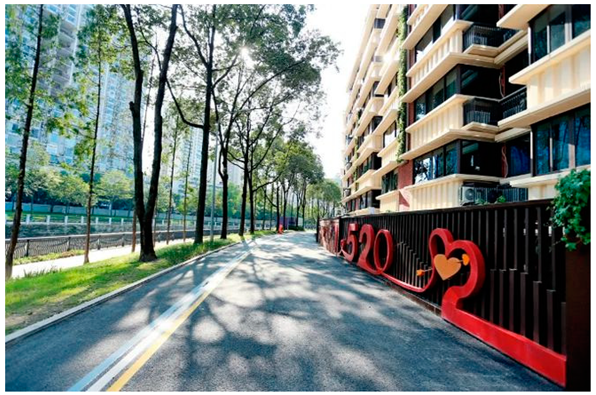
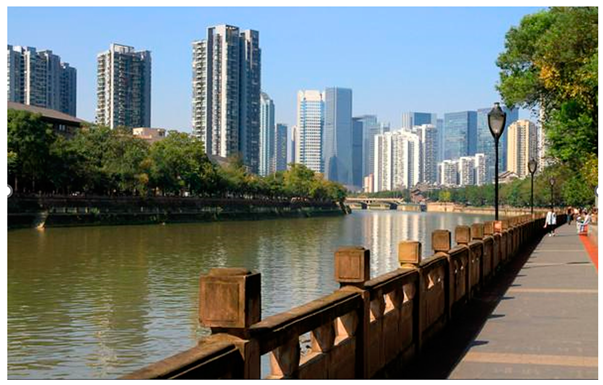
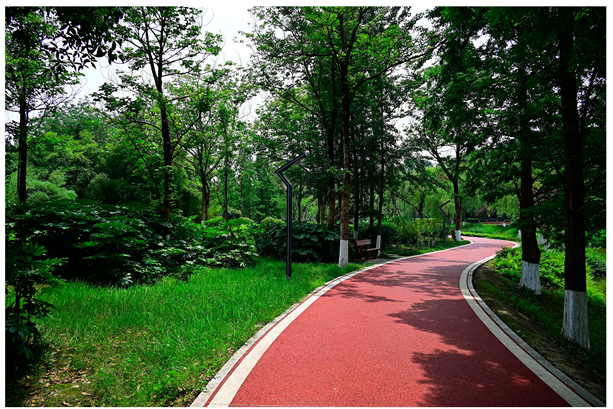
- 8.
- How do you think the presence of infrastructure on streets physical environmental factors of infrastructure affects your choice of that road as a walking path? (A higher negative value means less likely to choose the path, a higher positive value means more likely to choose the path, 0 means no effect) [Matrix scale question]
| Environmental Factors | Score | ||||||
|---|---|---|---|---|---|---|---|
| −3 | −2 | −1 | 0 | 1 | 2 | 3 | |
| Streetlights and lighting facilities | |||||||
| Guardrails | |||||||
| Signage | |||||||
| Garbage cans | |||||||
| Wire poles | |||||||
| Billboards | |||||||
| Street cameras | |||||||
| High voltage boxes | |||||||
| Retail stores | |||||||
| Restaurants | |||||||
| Teahouses | |||||||
| Bars | |||||||
| Cafés | |||||||
| Internet cafes | |||||||
| Food markets/hypermarkets | |||||||
| Mobile stalls | |||||||
| Toilets | |||||||
| Community clinics/hospitals | |||||||
| Community fitness equipment | |||||||
| Community service centers | |||||||
| Bus Stations | |||||||
| Subway Stations | |||||||
| Cab stands | |||||||
| Bicycle parking | |||||||
- 9.
- How do you think the presence of streets physical environmental factors of walking conditions affects your choice of that road as a walking path? (A higher negative value means less likely to choose the path, a higher positive value means more likely to choose the path, 0 means no effect) [Matrix scale question]
| Environmental Factors | Score | ||||||
|---|---|---|---|---|---|---|---|
| −3 | −2 | −1 | 0 | 1 | 2 | 3 | |
| Traffic signals | |||||||
| Crossroads | |||||||
| Ramps | |||||||
| Sidewalks | |||||||
| Pedestrian bridges | |||||||
| Underpasses | |||||||
| Level ground | |||||||
| Ground paving | |||||||
| Road greenery | |||||||
- 10.
- How do you think the presence of streets physical environmental factors of environmental quality affects your choice of that road as a walking path? (A higher negative value means less likely to choose the path, a higher positive value means more likely to choose the path, 0 means no effect) [Matrix scale question]
| Environmental Factors | Score | ||||||
|---|---|---|---|---|---|---|---|
| −3 | −2 | −1 | 0 | 1 | 2 | 3 | |
| Road greenery | |||||||
| Green space along the street | |||||||
| Artificial landscape | |||||||
| Litter on the street | |||||||
| Seating | |||||||
| Gazebo | |||||||
| Fountain | |||||||
| Tree pond with seating | |||||||
- 11.
- How do you think the presence of the streets s aesthetic environmental factors affects your choice of that road as a walking path? (A higher negative value means less likely to choose the path, a higher positive value means more likely to choose the path, 0 means no effect) [Matrix Scale Questions]
| Dimension | Environmental Factors | Score | ||||||
|---|---|---|---|---|---|---|---|---|
| −3 | −2 | −1 | 0 | 1 | 2 | 3 | ||
| Subjective perception | Diversity | |||||||
| Convenience | ||||||||
| Uniformity | ||||||||
| Novelty | ||||||||
| Maintainability | ||||||||
| Charm | ||||||||
| Sense of mystery | ||||||||
| Sensory perception | Pleasant sounds | |||||||
| Noise | ||||||||
| Pleasant odors | ||||||||
References
- Wang, R.; Liu, Y.; Lu, Y.; Zhang, J.; Liu, P.; Yao, Y.; Grekousis, G. Perceptions of built environment and health outcomes for older Chinese in Beijing: A big data approach with street view images and deep learning technique. Comput. Environ. Urban Syst. 2019, 78, 101386. [Google Scholar] [CrossRef]
- Cao, X.Y.; Handy, S.L.; Mokhtarian, P.L. The influences of the built environment and residential self-selection on pedestrian behavior: Evidence from Austin, TX. Transportation 2006, 33, 1–20. [Google Scholar] [CrossRef]
- Handy, S.; Cao, X.Y.; Mokhtarian, P. Correlation or causality between the built environment and travel behavior? Evidence from Northern California. Transp. Res. D Transp. Environ. 2005, 10, 427–444. [Google Scholar] [CrossRef]
- Saelens, B.E.; Handy, S.L. Built environment correlates of walking: A review. Med. Sci. Sport. Exerc. 2008, 40, S550–S566. [Google Scholar] [CrossRef]
- Merriman, P. Driving places—Marc Auge, non-places, and the geographies of England’s M1 motorway. Theory Cult. Soc. 2004, 21, 145–167. [Google Scholar] [CrossRef]
- Constitution of the World Health Organization. Available online: https://apps.who.int/gb/bd/PDF/bd47/EN/constitution-en.pdf?ua=1 (accessed on 30 March 2023).
- Kan, Z.; Kwan, M.-P.; Ng, M.K.; Tieben, H. The Impacts of Housing Characteristics and Built-Environment Features on Mental Health. Int. J. Environ. Res. Public Health 2022, 19, 5143. [Google Scholar] [CrossRef]
- Frank, L.D.; Engelke, P. Multiple impacts of the built environment on public health: Walkable places and the exposure to air pollution. Int. Reg. Sci. Rev. 2005, 28, 193–216. [Google Scholar] [CrossRef]
- Zhai, Y.; Baran, P.K. Urban park pathway design characteristics and senior walking behavior. Urban For. Urban Green. 2017, 21, 60–73. [Google Scholar] [CrossRef]
- Frank, L.D.; Engelke, P.O. The built environment and human activity patterns: Exploring the impacts of urban form on public health. J. Plan. Lit. 2001, 16, 202–218. [Google Scholar] [CrossRef]
- Sundquist, K.; Eriksson, U.; Kawakami, N.; Skog, L.; Ohlsson, H.; Arvidsson, D. Neighborhood walkability, physical activity, and walking behavior: The Swedish Neighborhood and Physical Activity (SNAP) study. Soc. Sci. Med. 2011, 72, 1266–1273. [Google Scholar] [CrossRef]
- Van Holle, V.; Deforche, B.; Van Cauwenberg, J.; Goubert, L.; Maes, L.; Van de Weghe, N.; De Bourdeaudhuij, I. Relationship between the physical environment and different domains of physical activity in European adults: A systematic review. BMC Public Health 2012, 12, 807. [Google Scholar] [CrossRef]
- Saelens, B.E.; Sallis, J.F.; Frank, L.D. Environmental correlates of walking and cycling: Findings from the transportation, urban design, and planning literatures. Ann. Behav. Med. 2003, 25, 80–91. [Google Scholar] [CrossRef]
- Hillsdon, M.; Thorogood, M.; Anstiss, T.; Morris, J. Randomized Controlled Trials of Physical-Activity Promotion in Free-Living Populations—A Review. J. Epidemiol. Community Health 1995, 49, 448–453. [Google Scholar] [CrossRef]
- Lee, I.-M.; Paffenbarger, R.S., Jr. Associations of Light, Moderate, and Vigorous Intensity Physical Activity with Longevity: The Harvard Alumni Health Study. Am. J. Epidemiol. 2000, 151, 293–299. [Google Scholar] [CrossRef]
- Baker, G.; Gray, S.R.; Wright, A.; Fitzsimons, C.; Nimmo, M.; Lowry, R.; Mutrie, N.; Scottish Phys Activity Res, C. The effect of a pedometer-based community walking intervention “Walking for Wellbeing in the West” on physical activity levels and health outcomes: A 12-week randomized controlled trial. Int. J. Behav. Nutr. Phys. Act. 2008, 5, 44. [Google Scholar] [CrossRef]
- Morris, J.N.; Hardman, A.E. Walking to health. Sport. Med. 1997, 23, 306–332. [Google Scholar] [CrossRef]
- Kelly, P.; Murphy, M.; Mutrie, N. The Health Benefits of Walking. Walking 2017, 9, 61–79. [Google Scholar]
- Evenson, K.R.; Eyler, A.A.; Wilcox, S.; Thompson, J.L.; Burke, J.E. Test-retest reliability of a questionnaire on physical activity and its correlates among women from diverse racial and ethnic groups. Am. J. Prev. Med. 2003, 25, 15–22. [Google Scholar] [CrossRef]
- Lee, I.M.; Buchner, D.M. The importance of walking to public health. Med. Sci. Sports Exerc. 2008, 40, S512–S518. [Google Scholar] [CrossRef]
- Krogh, C.M.E.; Gillis, L.; Kouwen, N.; Aramini, J. WindVOiCe, a Self-Reporting Survey: Adverse Health Effects, Industrial Wind Turbines, and the Need for Vigilance Monitoring. Bull. Sci. Technol. Soc. 2011, 31, 334–345. [Google Scholar] [CrossRef]
- Prohaska, T.R.; Eisenstein, A.R.; Satariano, W.A.; Hunter, R.; Bayles, C.M.; Kurtovich, E.; Kealey, M.; Ivey, S.L. Walking and the Preservation of Cognitive Function in Older Populations. Gerontologist 2009, 49, S86–S93. [Google Scholar] [CrossRef] [PubMed]
- Schubert, C.R.; Fischer, M.E.; Pinto, A.A.; Klein, B.E.K.; Klein, R.; Tweed, T.S.; Cruickshanks, K.J. Sensory Impairments and Risk of Mortality in Older Adults. J. Gerontol. A Biol. Sci. Med. Sci. 2017, 72, 710–715. [Google Scholar] [CrossRef] [PubMed]
- Trudeau, D. A typology of New Urbanism neighborhoods. J. Urban. Int. Res. Placemaking Urban Sustain. 2013, 6, 113–138. [Google Scholar] [CrossRef]
- Li, Y.; Peng, L.; Wu, C.; Zhang, J. Street View Imagery (SVI) in the Built Environment: A Theoretical and Systematic Review. Buildings 2022, 12, 1167. [Google Scholar] [CrossRef]
- Talen, E. Do-it-Yourself Urbanism:A History. J. Plan. Hist. 2015, 14, 135–148. [Google Scholar] [CrossRef]
- Sallis, J.F.; Floyd, M.F.; Rodriguez, D.A.; Saelens, B.E. Role of Built Environments in Physical Activity, Obesity, and Cardiovascular Disease. Circulation 2012, 125, 729–737. [Google Scholar] [CrossRef]
- Durand, C.P.; Andalib, M.; Dunton, G.F.; Wolch, J.; Pentz, M.A. A systematic review of built environment factors related to physical activity and obesity risk: Implications for smart growth urban planning. Obes. Rev. 2011, 12, e173–e182. [Google Scholar] [CrossRef]
- Sallis, J.F.; Cerin, E.; Conway, T.L.; Adams, M.A.; Frank, L.D.; Pratt, M.; Salvo, D.; Schipperijn, J.; Smith, G.; Cain, K.L.; et al. Physical activity in relation to urban environments in 14 cities worldwide: A cross-sectional study. Lancet 2016, 387, 2207–2217. [Google Scholar] [CrossRef]
- Olszewski, P.; Wibowo, S.S. Using Equivalent Walking Distance to Assess Pedestrian Accessibility to Transit Stations in Singapore. Transp. Res. Rec. 2005, 1927, 38–45. [Google Scholar] [CrossRef]
- Guo, Z.; Loo, B.P.Y. Pedestrian environment and route choice: Evidence from New York City and Hong Kong. J. Transp. Geogr. 2013, 28, 124–136. [Google Scholar] [CrossRef]
- Borst, H.C.; de Vries, S.I.; Graham, J.M.A.; van Dongen, J.E.F.; Bakker, I.; Miedema, H.M.E. Influence of environmental street characteristics on walking route choice of elderly people. J. Environ. Psychol. 2009, 29, 477–484. [Google Scholar] [CrossRef]
- Muraleetharan, T.; Hagiwara, T. Overall level of service of urban walking environment and its influence an pedestrian route choice behavior—Analysis of pedestrian travel in Sapporo, Japan. Transp. Res. Rec. 2007, 2002, 7–17. [Google Scholar] [CrossRef]
- Broach, J.; Dill, J. Pedestrian Route Choice Model Estimated from Revealed Preference GPS Data. In Proceedings of the Transportation Research Board 94th Annual Meeting, Washington, DC, USA, 11–15 January 2015. [Google Scholar]
- Siregar, A. Aesthetics of the Street Environment and the Link to Street Activity. Master’s Thesis, University of Leeds, Leeds, UK, 2011. [Google Scholar]
- Smardon, R.C. Perception and Aesthetics of the Urban-Environment—Review of the Role of Vegetation. Landsc. Urban Plan. 1988, 15, 85–106. [Google Scholar] [CrossRef]
- Danaci, H.M.; Kiran, G.S. Examining the Factor of Color on Street Facades in Context of the Perception of Urban Aesthetics: Example of Antalya. Int. J. Curric. Instr. 2020, 12, 222–232. [Google Scholar]
- Folkmann, M.N. Evaluating Aesthetics in Design: A Phenomenological Approach. Des. Issues 2010, 26, 40–53. [Google Scholar] [CrossRef]
- Ball, K.; Bauman, A.; Leslie, E.; Owen, N. Perceived environmental aesthetics and convenience and company are associated with walking for exercise among Australian adults. Prev. Med. 2001, 33, 434–440. [Google Scholar] [CrossRef]
- Ellaway, A.; Macintyre, S.; Bonnefoy, X. Graffiti, greenery, and obesity in adults: Secondary analysis of European cross sectional survey. BMJ Br. Med. J. 2005, 331, 611–612. [Google Scholar] [CrossRef]
- Handy, S.L.; Boarnet, M.G.; Ewing, R.; Killingsworth, R.E. How the built environment affects physical activity—Views from urban planning. Am. J. Prev. Med. 2002, 23, 64–73. [Google Scholar] [CrossRef]
- Ewing, R.; Handy, S. Measuring the Unmeasurable: Urban Design Qualities Related to Walkability. J. Urban Des. 2009, 14, 65–84. [Google Scholar] [CrossRef]
- Koo, B.W.; Guhathakurta, S.; Botchwey, N. How are Neighborhood and Street-Level Walkability Factors Associated with Walking Behaviors? A Big Data Approach Using Street View Images. Environ. Behav. 2022, 54, 211–241. [Google Scholar] [CrossRef]
- Zhao, J.; Xu, W.; Ye, L. Effects of auditory-visual combinations on perceived restorative potential of urban green space. Appl Acoust 2018, 141, 169–177. [Google Scholar] [CrossRef]
- Koh, P.P.; Wong, Y.D. Comparing pedestrians’ needs and behaviours in different land use environments. J. Transp. Geogr. 2013, 26, 43–50. [Google Scholar] [CrossRef]
- Hong, X.-C.; Cheng, S.; Liu, J.; Dang, E.; Wang, J.-B.; Cheng, Y. The Physiological Restorative Role of Soundscape in Different Forest Structures. Forests 2022, 13, 1920. [Google Scholar] [CrossRef]
- Hong, X.-C.; Liu, J.; Wang, G.-Y. Soundscape in Urban Forests. Forests 2022, 13, 2056. [Google Scholar] [CrossRef]
- Montello, D.R.; Goodchild, M.F.; Gottsegen, J.; Fohl, P. Where’s Downtown?: Behavioral Methods for Determining Referents of Vague Spatial Queries. Spat. Cogn. Comput. 2003, 3, 185–204. [Google Scholar] [CrossRef]
- Creswell, J.W.; Creswell, J.D. Research Design: Qualitative, Quantitative, and Mixed Methods Approaches, 3rd ed.; SAGE Publications: London, UK, 2018. [Google Scholar]
- Long, Y.; Wu, K.; Mao, Q. Simulating Urban Expansion in the Parcel Level for All Chinese Cities. arXiv 2014, arXiv:1402.3718. [Google Scholar]
- Zhong, Q.; Li, B.; Chen, Y. How Do Different Urban Footpath Environments Affect the Jogging Preferences of Residents of Different Genders? Empirical Research Based on Trajectory Data. Int. J. Environ. Res. Public Health 2022, 19, 14372. [Google Scholar] [CrossRef]
- Davies, J.S. The governance of urban regeneration: A critique of the ‘governing without government’ thesis. Public Adm. 2002, 80, 301–322. [Google Scholar] [CrossRef]
- Miranda, A.S.; Fan, Z.; Duarte, F.; Ratti, C. Desirable streets: Using deviations in pedestrian trajectories to measure the value of the built environment. Comp. Env. Urban Syst. 2021, 86, 101563. [Google Scholar] [CrossRef]
- Guo, Z. Does the pedestrian environment affect the utility of walking? A case of path choice in downtown Boston. Trans. Res. Part D Tran. Environ. 2009, 14, 343–352. [Google Scholar] [CrossRef]
- Alves, S.; Aspinall, P.A.; Ward Thompson, C.; Sugiyama, T.; Brice, R.; Vickers, A. Preferences of older people for environmental attributes of local parks. Facilities 2008, 26, 433–453. [Google Scholar] [CrossRef]
- Niu, X.; Wu, W.; Li, M. Influence of Built Environment on Street Vitality and Its Spatiotemporal Characteristics Based on LBS Positioning Data. Urban Plan. Int. 2019, 34, 28–37. [Google Scholar] [CrossRef]
- Seneviratne, P.N.; Morrall, J.F. Analysis of factors affecting the choice of route of pedestrians. Trans. Plan. Technol. 1985, 10, 147–159. [Google Scholar] [CrossRef]
- Hauru, K.; Koskinen, S.; Kotze, D.J.; Lehvavirta, S. The effects of decaying logs on the aesthetic experience and acceptability of urban forests—Implications for forest management. Landsc. Urban Plan. 2014, 123, 114–123. [Google Scholar] [CrossRef]
- Blumentrath, C.; Tveit, M.S. Visual characteristics of roads: A literature review of people’s perception and Norwegian design practice. Trans. Res. Part A Policy Pract. 2014, 59, 58–71. [Google Scholar] [CrossRef]
- Coeterier, J.F. Dominant attributes in the perception and evaluation of the Dutch landscape. Landsc. Urban Plan. 1996, 34, 27–44. [Google Scholar] [CrossRef]
- Peschardt, K.K.; Stigsdotter, U.K. Associations between park characteristics and perceived restorativeness of small public urban green spaces. Landsc. Urban Plan. 2013, 112, 26–39. [Google Scholar] [CrossRef]
- Mesimaki, M.; Hauru, K.; Kotze, D.J.; Lehvavirta, S. Neo-spaces for urban livability? Urbanites’ versatile mental images of green roofs in the Helsinki metropolitan area, Finland. Land Use Policy 2017, 61, 587–600. [Google Scholar] [CrossRef]
- Chen, B.; Adimo, O.A.; Bao, Z. Assessment of aesthetic quality and multiple functions of urban green space from the users’ perspective: The case of Hangzhou Flower Garden, China. Landsc. Urban Plan. 2009, 93, 76–82. [Google Scholar] [CrossRef]
- Kirillova, K.; Fu, X.; Lehto, X.; Cai, L. What makes a destination beautiful? Dimensions of tourist aesthetic judgment. Tour. Manag. 2014, 42, 282–293. [Google Scholar] [CrossRef]
- Hattie, J. Methodology Review—Assessing Unidimensionality of Tests and Items. Appl. Psych. Meas. 1985, 9, 139–164. [Google Scholar] [CrossRef]
- Landis, J.R.; Koch, G.G. The Measurement of Observer Agreement for Categorical Data. Biometrics 1977, 33, 159–174. [Google Scholar] [CrossRef] [PubMed]
- Handy, S.; Cao, X.Y.; Mokhtarian, P.L. Self-selection in the relationship between the built environment and walking—Empirical evidence from northern California. J. Am. Plann. Assoc. 2006, 72, 55–74. [Google Scholar] [CrossRef]
- Sahani, R.; Bhuyan, P.K. Pedestrian Level of Service Criteria for Urban Off-Street Facilities in Mid-Sized Cities. Transport 2017, 32, 221–232. [Google Scholar] [CrossRef]
- Caesarina, H.M.; Humaida, N.; Amali, M.F.; Wahyudi, M.W. The Need of Green Open Spacesa as the Effect of Urban Waterfront Development in Sungai Bilu, a Stream Corridor Neighbourhood in Banjarmasin. In Proceedings of the 5th International Conference on Sustainable Built Environment (ICSBE)—Management of Changes for Livable Environment, Banjarmasin, Indonesia, 11–13 October 2019. [Google Scholar]
- Saito, Y. Future Directions for Environmental Aesthetics. Environ. Value 2010, 19, 373–391. [Google Scholar] [CrossRef]
- Guo, X.; Liu, J.; Chen, Z.; Hong, X.-C. Harmonious Degree of Sound Sources Influencing Visiting Experience in Kulangsu Scenic Area, China. Forests 2023, 14, 138. [Google Scholar] [CrossRef]


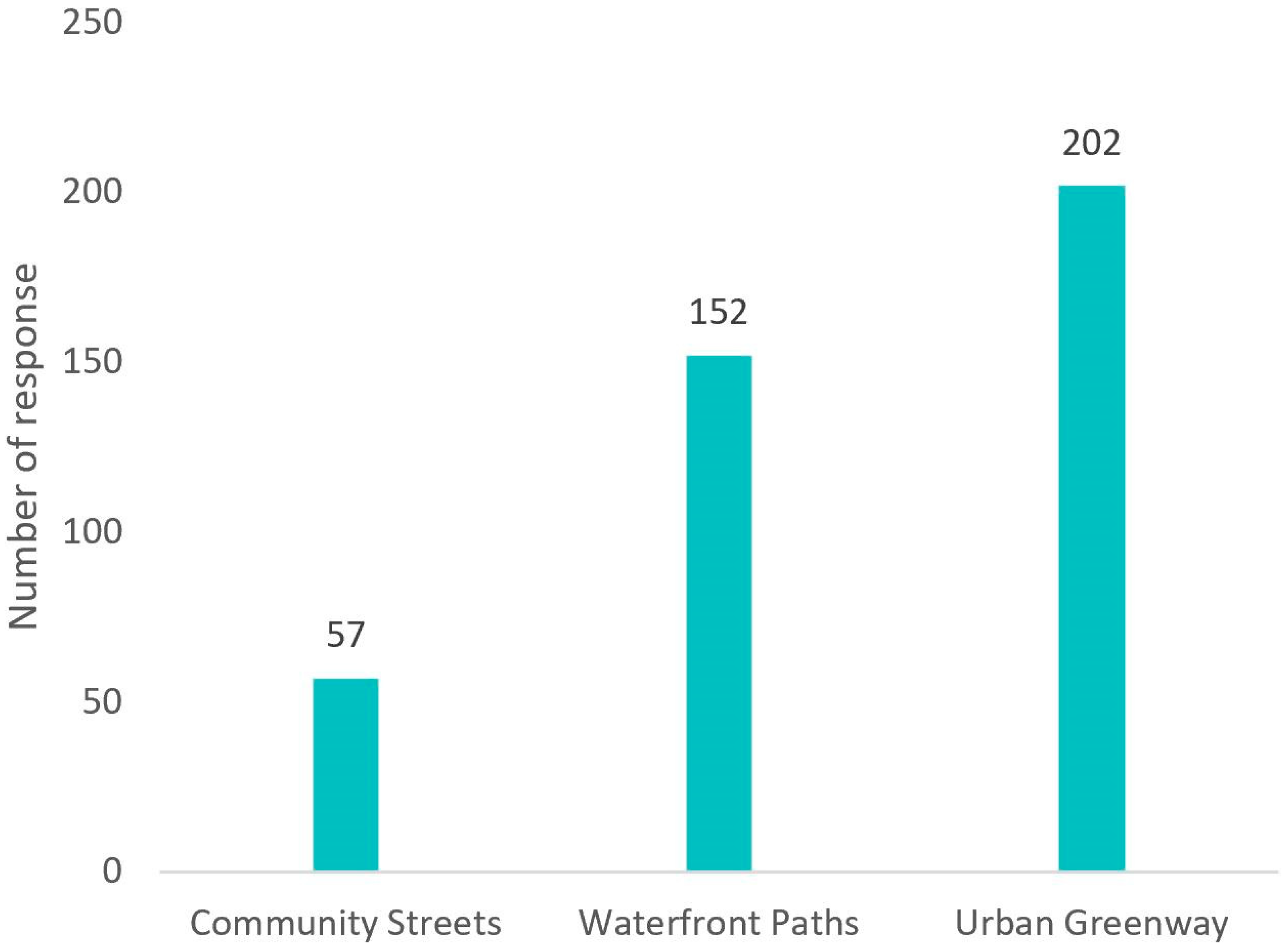
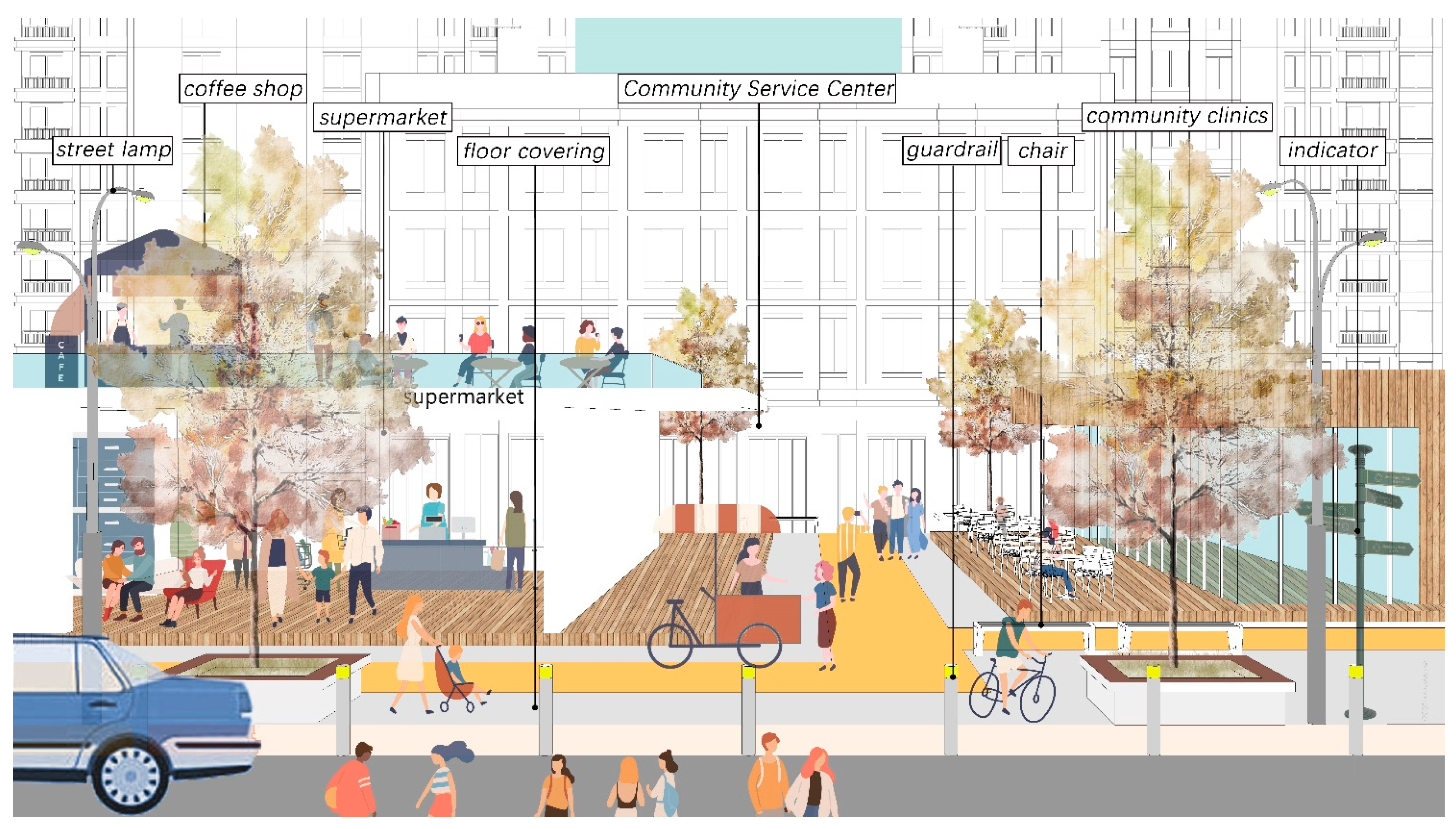
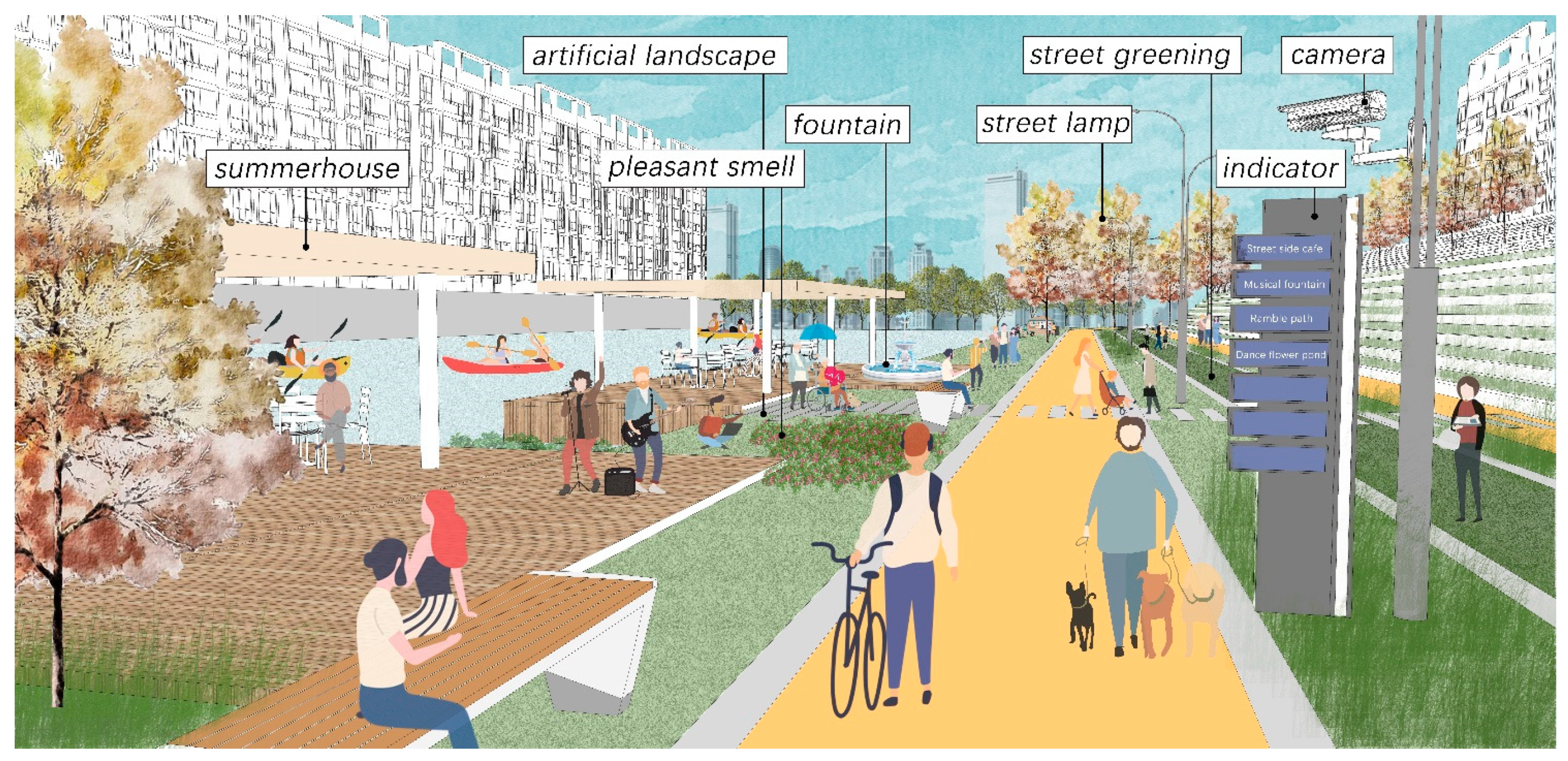
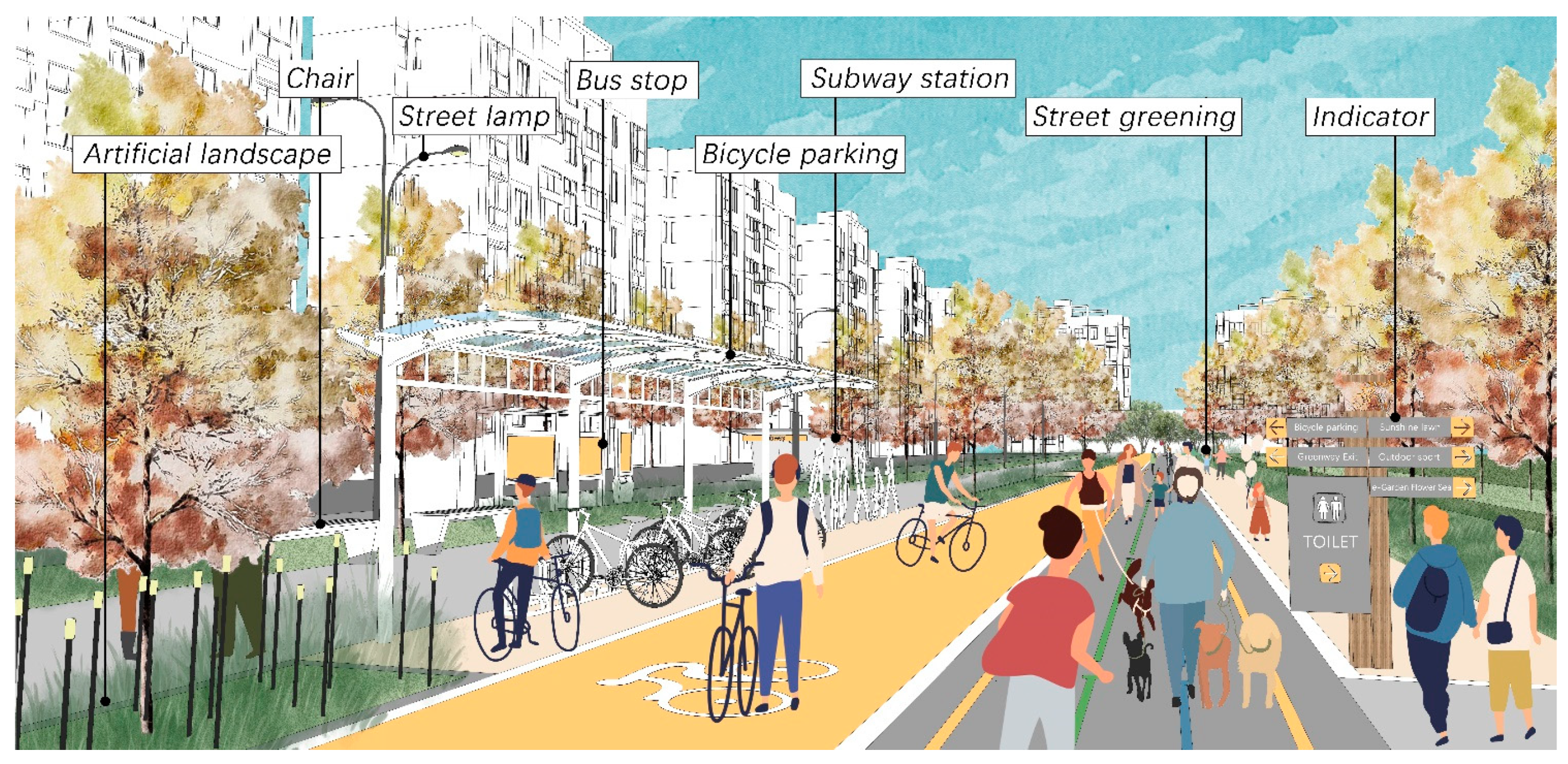
| Environmental Factors | Environmental Factor Layer 1 | Environmental Factor Layer 2 | Rationale |
|---|---|---|---|
| Physical Environmental Factors | Infrastructure (road functional facilities) | Lighting Guardrails Signage Garbage cans Power poles Billboards Street cameras High-voltage boxes | Streetscape elements such as guardrails, trash cans, and other streetscape elements are related to pedestrian walking preferences [52]; urban furniture is related to elements of the built environment and the pedestrian walking experience [53]. |
| Infrastructure (service facilities) | Retail stores Restaurants Teahouses Bars Cafes Internet cafes Hypermarkets Mobile stalls Toilets Community clinics Community fitness equipment Community service centers | Changes in a built environment’s general functions are significant, and pedestrians prefer routes that pass through more stores and services on the ground floor [31,54]. Providing public amenities can boost walkability [24,25,26]. When determining pedestrian route selection, public amenity data frequently include parks, restaurants, cafes, stores, medical services, and recreational facilities [27]. Some pedestrians’ walking preferences are positively correlated with the presence of restrooms [55]. | |
| Infrastructure (road traffic facilities) | Bus Stations Subway Stations Cab stops Bicycle parking | The volume of motor vehicle traffic also influences pedestrian preferences [56]. The presence of subway station entrances and exits enhances the vitality of a street. Additionally, bus stops, transit stations, and taxi stand influence residents’ walking patterns [45,57]. | |
| Pedestrian conditions | Traffic lights Crossroads Ramps Sidewalks Pedestrian bridges Underpasses Level ground Ground paving Road greening Green space along The street Artificial landscape Litter on the street Seating Gazebo Fountain Street tree box with seating | High activity levels near underpass entrances and pedestrian bridges also influence residents’ walking activity [57]; pedestrian path preferences are associated with sidewalks [53]. Green space behavior is positively correlated with pedestrian walkability [53]; pedestrian walking and pocket parks are positively correlated [55]; benches are also associated with pedestrian walking [52,53]. | |
| Aesthetic environmental factors | Environmental quality | Diversity Facility Accessibility Uniformity Novelty Maintainability Charm Sense of mystery | Diversity can be used to evaluate the impact of the environment on its inhabitants [58,59]; coherence has many characteristics, including a reflection of unity, balance, harmony, direction, and legibility, as well as understanding the totality of place and its relationship to itself [59,60,61]; mystery is associated with perceived complexity and attractiveness [58]. |
| Subjective perception | Pleasant sounds Pleasant odors | The multisensory nature of aesthetic experience is connected with the sounds of the built environment that impact pedestrians [58,62,63], the richness and diversity of odor characteristics, etc., which reflect the observed diversity of things [58,59,64]. |
| Category | Sub-Category | Frequency (N = 411) | Percentage of Respondents (%) |
|---|---|---|---|
| Gender | Female | 241 | 58.64 |
| Male | 170 | 41.36 | |
| Age | 18–25 years old | 107 | 26.03 |
| 26–55 years old | 145 | 35.28 | |
| 55+ years old | 159 | 38.69 | |
| Educational Level | High School and below | 86 | 20.92 |
| College | 86 | 20.92 | |
| Undergraduate | 167 | 40.63 | |
| Graduate | 72 | 17.52 | |
| Occupation | Medical personnel (doctors, nurses) | 14 | 3.41 |
| Teachers, lawyers, service industry workers (caterers/drivers/salesmen, etc.) | 35 | 8.52 | |
| Freelancer (e.g., writer/artist/photographer/guide, etc.) | 34 | 8.27 | |
| Workers (e.g., factory workers/construction workers/city sanitation workers, etc.) | 16 | 3.89 | |
| Company employees | 68 | 16.55 | |
| Career/civil servants/government workers | 32 | 7.79 | |
| Students | 91 | 22.14 | |
| Housewife | 19 | 4.62 | |
| No job/retired | 102 | 24.82 | |
| Have a driver’s license | Yes | 294 | 71.53 |
| No | 117 | 28.47 | |
| Monthly income | Less than 1500 RMB | 57 | 13.87 |
| 1500–3500 RMB | 82 | 19.95 | |
| 3500–4500 RMB | 67 | 16.3 | |
| 4500–8000 RMB | 133 | 32.36 | |
| 8000–15,000 RMB | 55 | 13.38 | |
| More than 15,000 RMB | 17 | 4.14 |
| Street Settings (Ref. Category: Community Streets) | B | Standard Error | Wald | df | Sig. | Exp (B) | Confidence Interval 95% of Exp (B) | ||
|---|---|---|---|---|---|---|---|---|---|
| Lower Limit | Upper Limit | ||||||||
| Waterfront Paths | intercept | 0.691 | 1.273 | 0.295 | 1 | 0.587 | - | ||
| Age | −0.203 | 0.178 | 1.306 | 1 | 0.253 | 0.816 | 0.576 | 1.156 | |
| Gender | −0.125 | 0.349 | 0.128 | 1 | 0.720 | 0.883 | 0.446 | 1.748 | |
| Education | 0.539 | 0.208 | 6.741 | 1 | 0.009 * | 1.715 | 1.141 | 2.577 | |
| Car Access | 0.365 | 0.410 | 0.793 | 1 | 0.373 | 1.441 | 0.645 | 3.219 | |
| Income | −0.161 | 0.158 | 1.035 | 1 | 0.309 | 0.851 | 0.624 | 1.161 | |
| Urban Greenways | intercept | 2.353 | 1.207 | 3.802 | 1 | 0.051 | - | ||
| Age | −0.263 | 0.170 | 2.397 | 1 | 0.122 | 0.769 | 0.551 | 1.073 | |
| Gender | −0.164 | 0.332 | 0.243 | 1 | 0.622 | 0.849 | 0.443 | 1.628 | |
| Education | 0.160 | 0.197 | 0.660 | 1 | 0.417 | 1.174 | 0.797 | 1.728 | |
| Car Access | 0.141 | 0.391 | 0.130 | 1 | 0.718 | 1.152 | 0.535 | 2.479 | |
| Income | −0.104 | 0.152 | 0.468 | 1 | 0.494 | 0.901 | 0.669 | 1.214 | |
| AIC = 465.437 | |||||||||
| BIC = 513.660 | |||||||||
| Likelihood ratio: χ2 = 22.777, df = 10, p = 0.012 | |||||||||
| Dimensions | Items | Differential Analysis on Three Streets | Reliability Analysis | Validity Analysis | |||
|---|---|---|---|---|---|---|---|
| Statistics | df | Sig. | Cronbach’s Alpha | Kaiser-Meyer-Olkin Statistics | Sig. | ||
| Functional Facility | Lighting | 1.383 | 2 | 0.501 | 0.666 | 0.879 | <0.001 |
| Guardrails | 0.802 | 2 | 0.670 | ||||
| Signage | 3.057 | 2 | 0.217 | ||||
| Garbage cans | 1.283 | 2 | 0.527 | ||||
| Wire poles | 4.987 | 2 | 0.083 | ||||
| Billboards | 1.126 | 2 | 0.569 | ||||
| Street cameras | 2.684 | 2 | 0.261 | ||||
| High voltage boxes | 2.122 | 2 | 0.346 | ||||
| Service Facility | Retail stores | 0.552 | 2 | 0.759 | 0.774 | ||
| Restaurants | 1.332 | 2 | 0.514 | ||||
| Teahouses | 3.941 | 2 | 0.139 | ||||
| Bars | 0.296 | 2 | 0.862 | ||||
| Cafes | 4.558 | 2 | 0.102 | ||||
| Internet cafes | 0.613 | 2 | 0.736 | ||||
| Hypermarkets | 4.972 | 2 | 0.083 | ||||
| Mobile stalls | 2.424 | 2 | 0.298 | ||||
| Toilets | 0.130 | 2 | 0.937 | ||||
| Community clinics | 1.577 | 2 | 0.455 | ||||
| Community fitness equipment | 2.025 | 2 | 0.363 | ||||
| Community service centers | 2.482 | 2 | 0.289 | ||||
| Transportation Facility | Bus Stations | 4.987 | 2 | 0.083 | 0.866 | ||
| Subway Stations | 3.196 | 2 | 0.202 | ||||
| Cab stands | 2.135 | 2 | 0.344 | ||||
| Bicycle parking | 0.262 | 2 | 0.877 | ||||
| Walking Conditions | Traffic signals | 0.224 | 2 | 0.894 | 0.802 | ||
| Crossroads | 4.355 | 2 | 0.113 | ||||
| Ramps | 0.180 | 2 | 0.914 | ||||
| Sidewalks | 0.443 | 2 | 0.801 | ||||
| Pedestrian bridges | 1.782 | 2 | 0.410 | ||||
| Underpasses | 0.753 | 2 | 0.686 | ||||
| Leveled ground | 4.604 | 2 | 0.100 | ||||
| Paved Ground | 3.312 | 2 | 0.191 | ||||
| Environmental Quality | Road greenery | 3.248 | 2 | 0.197 | 0.724 | ||
| Green space along the street | 5.438 | 2 | 0.066 | ||||
| Artificial landscape | 2.992 | 2 | 0.224 | ||||
| Litter on the street | 0.259 | 2 | 0.879 | ||||
| Seating | 0.242 | 2 | 0.886 | ||||
| Gazebo | 4.987 | 2 | 0.083 | ||||
| Fountain | 1.990 | 2 | 0.370 | ||||
| Street tree box with seating | 1.275 | 2 | 0.529 | ||||
| Dimensions | Items | Community Streets (N = 57) | Waterfront Paths (N = 152) | Urban Greenways (N = 202) | |||||||||
|---|---|---|---|---|---|---|---|---|---|---|---|---|---|
| M | N | ○ | △ | M | N | ○ | △ | M | N | ○ | △ | ||
| Functional Street Facility | Lighting | 1.79 | √ | 1.82 | √ | 1.90 | √ | ||||||
| Guardrails | 1.32 | √ | 1.07 | √ | 1.16 | √ | |||||||
| Signage | 1.75 | √ | 1.40 | √ | 1.45 | √ | |||||||
| Garbage cans | 0.11 | √ | 0.32 | √ | 0.15 | √ | |||||||
| Wire poles | −1.23 | √ | −0.64 | √ | −0.78 | √ | |||||||
| Billboards | −0.70 | √ | −0.59 | √ | −0.53 | √ | |||||||
| Street cameras | 0.93 | √ | 1.18 | √ | 1.00 | √ | |||||||
| High voltage boxes | −1.12 | √ | −1.06 | √ | −1.28 | √ | |||||||
| Service Facility | Retail stores | 1.35 | √ | 1.21 | √ | 1.24 | √ | ||||||
| Restaurants | 1.04 | √ | 0.85 | √ | 0.76 | √ | |||||||
| Teahouses | 0.02 | √ | 0.50 | √ | 0.35 | √ | |||||||
| Bars | 0.04 | √ | −0.08 | √ | −0.11 | √ | |||||||
| Cafes | −0.23 | √ | 0.24 | √ | 0.15 | √ | |||||||
| Internet cafes | −0.65 | √ | −0.42 | √ | −0.50 | √ | |||||||
| Hypermarkets | 1.42 | √ | 0.97 | √ | 0.96 | √ | |||||||
| Mobile stalls | 0.89 | √ | 0.71 | √ | 0.45 | √ | |||||||
| Toilets | 1.35 | √ | 1.20 | √ | 1.17 | √ | |||||||
| Community clinics | 1.07 | √ | 0.76 | √ | 0.87 | √ | |||||||
| Community fitness equipment | 1.93 | √ | 1.74 | √ | 1.74 | √ | |||||||
| Community service centers | 1.07 | √ | 0.96 | √ | 1.20 | √ | |||||||
| Transportation Facility | Bus Stations | 1.33 | √ | 0.89 | √ | 1.32 | √ | ||||||
| Subway Stations | 0.96 | √ | 0.80 | √ | 1.12 | √ | |||||||
| Cab stands | 0.81 | √ | 0.59 | √ | 0.83 | √ | |||||||
| Bicycle parking | 0.96 | √ | 0.95 | √ | 1.01 | √ | |||||||
| Pedestrian Conditions | Community Streets (N = 57) | Waterfront Paths (N = 152) | Urban Greenways (N = 202) | |||||||||
|---|---|---|---|---|---|---|---|---|---|---|---|---|
| M | N | ○ | △ | M | N | ○ | △ | M | N | ○ | △ | |
| Traffic signals | 1.23 | √ | 1.1 | √ | 1.12 | √ | ||||||
| Crossroads | 0.96 | √ | 0.63 | √ | 0.49 | √ | ||||||
| Ramps | 0.39 | √ | 0.33 | √ | 0.41 | √ | ||||||
| Sidewalks | 1.25 | √ | 1.35 | √ | 1.29 | √ | ||||||
| Pedestrian bridges | 0.63 | √ | 0.67 | √ | 0.90 | √ | ||||||
| Underpasses | 0.63 | √ | 0.49 | √ | 0.47 | √ | ||||||
| Leveled ground | 1.98 | √ | 1.76 | √ | 1.99 | √ | ||||||
| Paved ground | 2.02 | √ | 1.69 | √ | 1.66 | √ | ||||||
| Pedestrian Conditions | Community Streets (N = 57) | Waterfront Paths (N = 152) | Urban Greenways (N = 202) | |||||||||
|---|---|---|---|---|---|---|---|---|---|---|---|---|
| M | N | ○ | △ | M | N | ○ | △ | M | N | ○ | △ | |
| Road greenery | 1.98 | √ | 2.20 | √ | 2.21 | √ | ||||||
| Green space along the street | 1.88 | √ | 2.22 | √ | 2.13 | √ | ||||||
| Artificial landscape | 1.77 | √ | 2.06 | √ | 2.00 | √ | ||||||
| Litter on the street | −1.7 | √ | −1.72 | √ | −1.59 | √ | ||||||
| Seating | 2.04 | √ | 1.93 | √ | 2.02 | √ | ||||||
| Gazebo | 1.63 | √ | 1.71 | √ | 1.97 | √ | ||||||
| Fountain | 1.88 | √ | 1.64 | √ | 1.65 | √ | ||||||
| Street tree box with seating | 1.82 | √ | 1.82 | √ | 1.95 | √ | ||||||
| Dimensions | Items | Differential Analysis on Three Streets | Reliability Analysis | Validity Analysis | |||
|---|---|---|---|---|---|---|---|
| Statistics | df | Sig. | Cronbach’s Alpha | Kaiser-Meyer-Olkin Statistics | Sig. | ||
| Subjective Perception | Diversity | 0.499 | 2 | 0.779 | 0.831 | 0.882 | <0.001 |
| Facility Accessibility | 0.034 | 2 | 0.983 | ||||
| Uniformity | 4.213 | 2 | 0.122 | ||||
| Novelty | 0.368 | 2 | 0.832 | ||||
| Maintainability | 3.498 | 2 | 0.174 | ||||
| Charm | 2.512 | 2 | 0.285 | ||||
| Sense of mystery | 3.000 | 2 | 0.223 | ||||
| Sensory Perception | Pleasant sounds | 1.895 | 2 | 0.388 | 0.573 | ||
| Pleasant odors | 0.634 | 2 | 0.728 | ||||
| Dimensions | Items | Community Streets (N = 57) | Waterfront Paths (N = 152) | Urban Greenways (N = 202) | |||||||||
|---|---|---|---|---|---|---|---|---|---|---|---|---|---|
| M | N | ○ | △ | M | N | ○ | △ | M | N | ○ | △ | ||
| Subjective perception | Diversity | 1.65 | √ | 1.63 | √ | 1.71 | √ | ||||||
| Facility Accessibility | 1.79 | √ | 1.8 | √ | 1.83 | √ | |||||||
| Uniformity | 1.63 | √ | 1.46 | √ | 1.72 | √ | |||||||
| Novelty | 1.65 | √ | 1.61 | √ | 1.69 | √ | |||||||
| Maintainability | 1.89 | √ | 1.94 | √ | 2.10 | √ | |||||||
| Charm | 2.02 | √ | 1.87 | √ | 2.00 | √ | |||||||
| Sense of mystery | 1.77 | √ | 1.67 | √ | 1.52 | √ | |||||||
| Sensory perception | Pleasant sounds | 1.13 | √ | 1.41 | √ | 1.25 | √ | ||||||
| Pleasant odors | 1.86 | √ | 2.01 | √ | 1.97 | √ | |||||||
| Factors | Dimensions | Community Streets | Waterfront Paths | Urban Greenways | |||
|---|---|---|---|---|---|---|---|
| Moderate Impact | Strong Impact | Moderate impact | Strong Impact | Moderate Impact | Strong Impact | ||
| Physical environmental factors | Infrastructure | Lighting Guardrails Signage Wire poles High-voltage boxes Retail stores Restaurants Hypermarkets Toilets Community clinics Community fitness equipment Community service centers Bus stations | Lighting Guardrails Signage Street cameras High voltage boxes Retail stores Toilets Community fitness equipment | Lighting Guardrails Signage Street cameras High voltage boxes Retail stores Toilets Community fitness equipment Community service canters Bus stations Subway stations Bicycle parking | |||
| Pedestrian conditions | Traffic signals Sidewalk Leveled ground | Paved ground | Traffic signals Sidewalk Leveled ground Paved ground | Traffic signal sidewalk Leveled ground Paved ground | |||
| Environmental quality | Road greening Green spaces along the street Artificial landscape Litter on the street Gazebo Fountain street tree box with seating | Seating | Litter on the street Seating Gazebo Fountain street tree box with seating | Road greening Green spaces along the street Artificial landscape | Litter on the street Gazebo Fountains street tree box with seats | Road greening Green spaces along the street Artificial landscape Seating | |
| Aesthetic environmental factors | Subjective perception | Diversity Facility Accessibility Uniformity Novelty Maintainability Sense of mystery | Charm | Diversity Facility Accessibility Uniformity Novelty Maintainability Charm Sense of mystery | Diversity Facility Accessibility Uniformity Novelty Fascination Sense of mystery | Maintainability Charm | |
| Sensory perception | Pleasant sounds Pleasant odors | Pleasant sounds | Pleasant odors | Pleasant sounds Pleasant odors | |||
Disclaimer/Publisher’s Note: The statements, opinions and data contained in all publications are solely those of the individual author(s) and contributor(s) and not of MDPI and/or the editor(s). MDPI and/or the editor(s) disclaim responsibility for any injury to people or property resulting from any ideas, methods, instructions or products referred to in the content. |
© 2023 by the authors. Licensee MDPI, Basel, Switzerland. This article is an open access article distributed under the terms and conditions of the Creative Commons Attribution (CC BY) license (https://creativecommons.org/licenses/by/4.0/).
Share and Cite
Yan, Q.; Luo, S.; Jiang, J. Urban Residents’ Preferred Walking Street Setting and Environmental Factors: The Case of Chengdu City. Buildings 2023, 13, 1199. https://doi.org/10.3390/buildings13051199
Yan Q, Luo S, Jiang J. Urban Residents’ Preferred Walking Street Setting and Environmental Factors: The Case of Chengdu City. Buildings. 2023; 13(5):1199. https://doi.org/10.3390/buildings13051199
Chicago/Turabian StyleYan, Qian, Shixian Luo, and Jiayi Jiang. 2023. "Urban Residents’ Preferred Walking Street Setting and Environmental Factors: The Case of Chengdu City" Buildings 13, no. 5: 1199. https://doi.org/10.3390/buildings13051199
APA StyleYan, Q., Luo, S., & Jiang, J. (2023). Urban Residents’ Preferred Walking Street Setting and Environmental Factors: The Case of Chengdu City. Buildings, 13(5), 1199. https://doi.org/10.3390/buildings13051199













